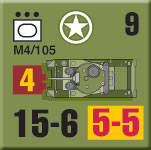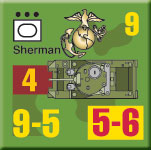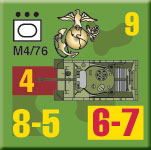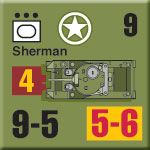| Sherman Tank Models
by Mike Bennighof, Ph.D.
October 2022
 Panzer Grenadier games include lots of M4 Sherman tanks: in different nationalities (U.S. Army, U.S. Marine, Soviet, British, Indian, Polish and even Japanese, plus Israeli and Egyptian Shermans in Panzer Grenadier (Modern): 1967 Sword of Israel). But there are only five different models, three differentiated by their armament (75mm, 76mm or 105mm) plus the Sherman Jumbo assault tank and the British Firefly conversion. Panzer Grenadier games include lots of M4 Sherman tanks: in different nationalities (U.S. Army, U.S. Marine, Soviet, British, Indian, Polish and even Japanese, plus Israeli and Egyptian Shermans in Panzer Grenadier (Modern): 1967 Sword of Israel). But there are only five different models, three differentiated by their armament (75mm, 76mm or 105mm) plus the Sherman Jumbo assault tank and the British Firefly conversion.
That squeezes a huge array of Sherman sub-types into just three categories. Panzer Grenadier is a relatively simple game system, as tactical combat games go, and most of the differences just aren’t enough to show up at this scale. Others make so little difference that the confusion of different playing pieces for them isn’t worth the additional burden on ease of play.
Officially, the tank was known as the M4 in the U.S. Army; the name “Sherman” came from the British and began to filter into American use, including official documents, almost immediately. Just over 49,000 Shermans of all sub-types would be manufactured. Another 2,000 of the similar Canadian Ram tank would be built by Montreal Locomotive Works.

The first Shermans and last M3 Grants at Detroit Tank Arsenal.
Sherman production began in February 1942 with the M4A1 model, with the M4A2 starting up in April. Three factories built 6,281 of the M4A1, while five plants churned out 8,053 of the M4A2. The M4A1 had a radial engine derived from an aircraft power plant and a fully cast hull; the M4A2 was diesel-powered with a welded hull. They both carried the M2 75mm tank gun, the same weapon with which the preceding M3 medium tank had been armed. U.S. Army units received the M4A1, while the M4A2 went to lower-priority recipients including Lend-Lease partners and the U.S. Marines.
 The M4A3 entered production in June; it had a Ford V8 engine and welded hull. Ford built 1,690 of them and it became the favored sub-model of the U.S. Army. Two similar models began production in July 1942, the M4 (6,748 of them produced at five different factories) and M4A4 (7,499 built, all at Detroit Tank Arsenal). They differed in type of engine, and the M4A4 had a slightly modified hull. The M4A4 went only to Lend-Lease users, chiefly Britain, and about 2,000 of those sent to the British would be converted to Firefly configuration armed with the powerful 17-pounder gun in place of the 75mm cannon. The M4A3 entered production in June; it had a Ford V8 engine and welded hull. Ford built 1,690 of them and it became the favored sub-model of the U.S. Army. Two similar models began production in July 1942, the M4 (6,748 of them produced at five different factories) and M4A4 (7,499 built, all at Detroit Tank Arsenal). They differed in type of engine, and the M4A4 had a slightly modified hull. The M4A4 went only to Lend-Lease users, chiefly Britain, and about 2,000 of those sent to the British would be converted to Firefly configuration armed with the powerful 17-pounder gun in place of the 75mm cannon.
Those five models represent slightly more than half of the total production of Sherman tanks. All five are lumped together in Panzer Grenadier as the “Sherman,” or “M4” in some of the earlier games in the series.
 All five models were in production simultaneously, with a few other minor differences between them. Almost all parts were interchangeable between them, greatly easing provision of spare parts and allowing one tank to be cannibalized to repair another even if they were of different sub-models. That great strength of the American system assured that not only would the Sherman be available in huge numbers, but those at the front could be kept in service. All five models were in production simultaneously, with a few other minor differences between them. Almost all parts were interchangeable between them, greatly easing provision of spare parts and allowing one tank to be cannibalized to repair another even if they were of different sub-models. That great strength of the American system assured that not only would the Sherman be available in huge numbers, but those at the front could be kept in service.
That inter-changeability also allowed an armament upgrade, and in late 1943 the Army directed that the 75mm main gun be replaced by a 76mm weapon with a longer barrel and much higher muzzle velocity. Combat experience in North Africa showed that the 75mm gun had good performance against soft targets as befit its origins as an artillery piece. But it was less capable against enemy tanks, with the 76mm gun giving much better performance.
 Only three of the five base models were built with the 76mm gun (the M4A1, M4A2 and M4A3); others originally armed with the 75mm gun were upgraded in the field (many 76mm guns were shipped to Europe for this purpose). In Panzer Grenadier, all of these vehicles are represented by the M4/76. Only three of the five base models were built with the 76mm gun (the M4A1, M4A2 and M4A3); others originally armed with the 75mm gun were upgraded in the field (many 76mm guns were shipped to Europe for this purpose). In Panzer Grenadier, all of these vehicles are represented by the M4/76.
The British objected to the armament change, preferring the 75mm gun since the tanks rarely fought tanks: most engagements involving tanks, by far, were against enemy infantry or fortifications where the original gun’s better high-explosive round would be more useful. And so the Sherman continued in production with both 75mm and 76mm main guns.
There would be no M4A5 (that designation would have gone to Canadian-produced Shermans, which morphed into the Ram tank). The short-run M4A6 (just 75 of them made) had an experimental Caterpillar supercharged radial engine and the standard 75mm gun. Rather than design new tanks, the existing Sherman models would be modified and continue in production.
 Instead, the five base models would be modified, chiefly the M4A3. In addition to the new 76mm gun, other upgrades included wider tracks, improved suspensions, and “wet stowage” of main gun ammunition. Soon after its combat debut with British units in North Africa, the Sherman earned a reputation for burning or exploding when hit by enemy anti-tank fire. While crews at the time often attributed these fires to burning gasoline, they almost always resulted from a design flaw that placed ammunition supplies in the weakly-armored sponsons over the tracks. Instead, the five base models would be modified, chiefly the M4A3. In addition to the new 76mm gun, other upgrades included wider tracks, improved suspensions, and “wet stowage” of main gun ammunition. Soon after its combat debut with British units in North Africa, the Sherman earned a reputation for burning or exploding when hit by enemy anti-tank fire. While crews at the time often attributed these fires to burning gasoline, they almost always resulted from a design flaw that placed ammunition supplies in the weakly-armored sponsons over the tracks.
An innovative “wet stowage” system helped reduce that danger. An armored shell was placed around the ammunition racks, including a hollow casing filled with a mixture of water and glycerine. If a shot penetrated the armored casing, the mixture would leak out over the shells within and reduce the chances of fire and resulting explosion. The arrangement proved highly successful, with far fewer Shermans burning and exploding in combat.
While the 75mm gun had good performance against soft targets, a tank gun derived from the 105mm M4 howitzer gave even better results. The M4 model provided the basis for 1,641 vehicles starting in February 1944; another 3,039 based on the M4A3 were built starting in May 1944. Both of these tanks are classed together in Panzer Grenadier as the M4/105; all users of the Sherman including the ill-favored Marine Corps appear to have received at least some of them.
The Sherman Jumbo assault tank, officially the M4A3E2, appeared in the summer of 1944. It had additional armor applied to its front and its turret, greatly slowing it but providing some added protection. Crews often added more, and sometimes replaced the 75mm gun with the 76mm. Fisher Tank Arsenal produced 254 of this variant.

The M4 Sherman with 105mm howitzer.
The ultimate Sherman, the M4A3E8 “Easy Eight,” began production in August 1944 at Detroit Tank Arsenal, which built 2,617 of them though others were upgraded to the same standard. The Easy Eight had all of the modifications: widened tracks, improved suspension, wet ammunition stowage and the 76mm gun.
 The Sherman chassis would form the basis for even more vehicles: self-propelled artillery, tank recovery vehicles and tank destroyers. Production vehicles were fitted with flame throwers, rocket launchers, mine-clearing drums and hedgerow-cutting devices. The Sherman chassis would form the basis for even more vehicles: self-propelled artillery, tank recovery vehicles and tank destroyers. Production vehicles were fitted with flame throwers, rocket launchers, mine-clearing drums and hedgerow-cutting devices.
While not as powerful or well-armored as some of its opponents, the Sherman won the war not least because of its simplified production. Holding to five variations of a single base model allowed full use of mass production techniques and streamlined field maintenance procedures. The ugly little tank remains one of the finest weapons of war ever devised.
Our Golden Journal No. 27: Serman Tanks includes upgraded playing pieces for Panzer Grenadier, giving Shermans better protection values. The Golden Journal is only available to the Gold Club (that’s why we call it the Golden Journal). It’s free when we first offer it; afterwards it costs $12.99 because we want to encourage everyone to order right away but we still want to be able to keep them in stock for late arrivals.
Click here to join the Gold Club.
See your Gold Club Insider newsletter for ordering information.
Sign up for our newsletter right here. Your info will never be sold or transferred; we'll just use it to update you on new games and new offers.
Mike Bennighof is president of Avalanche Press and holds a doctorate in history from Emory University. A Fulbright Scholar and NASA Journalist in Space finalist, he has published a great many books, games and articles on historical subjects; people are saying that some of them are actually good.
He lives in Birmingham, Alabama with his wife, three children, and new puppy. He misses his lizard-hunting Iron Dog, Leopold.
Want to keep Daily Content free of third-party ads? You can send us some love (and cash) through this link right here.
|
